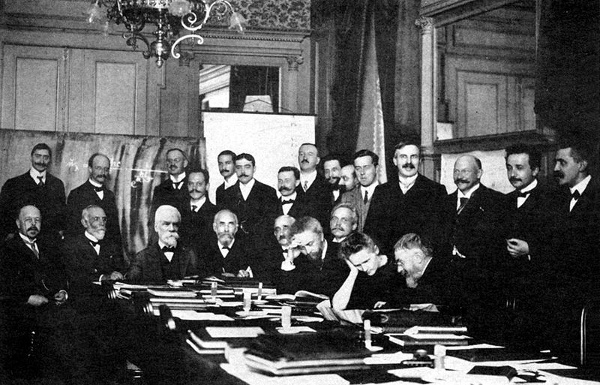The Carbon Footprint of Science
January 21, 2011
Scientists travel a lot. In my early years as an
industrial scientist, I would attend two topical conferences each year, and travel to company locations at least as often. As is true for most scientists, I had a favorite topical conference, which was the
Annual Conference on Magnetism and Magnetic Materials. This conference is much broader than its
magnetism title would indicate. For example,
superconductivity is a topic of this conference, and magnetism and superconductivity are as physically opposite as two solid state effects can get. Magnetism results from a parallel orientation of
electron spins in a material, whereas superconductivity needs electrons paired with antiparallel spins in "
Cooper pairs."
As graduate students quickly learn, the papers presented at conference are just part of a larger interchange of scientific information. Scientists talk in the corridors, over
coffee, and at lunch and dinner. Collaborations are hatched in the hallways, and tricks-of-the-trade that don't appear in the written literature are exchanged. Nowadays,
social media may be all the rage, but these face-to-face information exchanges were priceless. It was money well spent by my company, and time well spent by me.
Money was all we thought about in those days (a conference with airfare, lodging and meals would run at least $2,000 in
yesterday's money), but there's more to consider with today's understanding of mankind's
environmental footprint.[1] This point was made in a letter to
Science by Ingrid C. Burke of the
University of Wyoming (Laramie, WY).[2] Burke writes about her attendance at the 95th annual meeting of the
Ecological Society of America,[3] which is her favorite topical conference. The 2010 meeting was held in
Pittsburgh, which is becoming a popular conference venue,[4] from August 1-6, 2010. Burke was an author of a paper on carbon emissions during forest wildfires at that conference.[5]
The topic of this conference was "
Global Warming: The legacy of our past, the challenge for our future."[3] According to Burke's estimates, the 4,000 attendees at this conference traveled eight million miles and generated a
carbon footprint of about a thousand tons of
CO2. So, a meeting on Global Warming was a major contributor to the problem. One mitigating factor was the Society's purchase of a $5.00
carbon offset for each attendee, and Burke mentioned that there were other "green" measures implemented at the conference (no paper or
styrofoam coffee cups?).
Not that this conference should be singled out for special scorn. Every scientist seems to be responsible for an order of magnitude greater greenhouse gas emission than the average citizen. Burke proposes an idea that captured the corporate imagination many years ago. Travel less frequently and conduct business electronically by email, telephone,
wikis and
teleconferences. In my last few years as an industrial scientist, all my corporate business was done electronically. In prior years I would have averaged at least two visits to another company site. The only scientific conferences I attended in my last few years were at universities within a day's travel by automobile. Air travel was strongly discouraged, but that was for financial reasons. Now we have a better reason.

Participants of the first Solvay Conference (1911). Einstein, who is easily recognized, is flanked by Heike Kamerlingh Onnes on his right and Paul Langevin on his left.
It would not be prudent to apply this corporate model without change to scientific conferences. First, if the conference week were spent in your office watching teleconferenced presentations, too many people would interrupt. It would not be possible to free yourself from the pressing matters of your office while you're sitting in your office chair. Not only that, but the magic of casual interaction with your peers would be lost. You really need to remove yourself from your office and mix with other scientists, but how could this be done while maintaining a reduced carbon footprint?
Perhaps it would be possible to host a conference in a
distributed environment of several regional conference centers. These might be hosted at the larger universities. These centers would be
networked to have the conference appear the same at all locations. While staring at the
PowerPoint slides (I mean,
Open Office Presentation slides) on the screen at the front of the room, it would feel like the conferences of yesteryear, except for a fewer number of people in each session room. Questions to the presenters could be initiated from any of these distributed session rooms. There might be smaller video conference booths, always on, where scientists could gather for discussion across the conference network. This would be similar to the "Wall" experiment that linked Bell Labs lunchrooms across locations via perpetual videoconference several decades ago.[6]
References:
- There was a joke in one of my childhood books. A student was asked to define a "virgin forest." His answer was a forest where the hand of man had never set foot.
- Ingrid C. Burke, "Travel Trade-Offs for Scientists," Science vol. 330, no. 6010 (December 10, 2010) p. 1476.
- Website of the 95th annual meeting of the Ecological Society of America.
- Dialect (This Blog, January 10, 2011).
- Sara Brown, Indy Burke, William K. Lauenroth, and Daniel B. Tinker, "Quantifying aboveground carbon emissions during wildfire in the montane forest of the Colorado Front Range, U.S.A," Paper COS 99-7 of the 95th annual meeting of the Ecological Society of America, August 5, 2010.
- Sorry, I wasn't able to find a reference for this, but that's my recollection. I remember a story about this in New Scientist.
Permanent Link to this article
Linked Keywords: Scientist; industrial scientist; Annual Conference on Magnetism and Magnetic Materials; magnetism; superconductivity; electron; spin; Cooper pair; coffee; social media; time value of money; ecological footprint; environmental footprint; Science; University of Wyoming (Laramie, WY); Ecological Society of America; Pittsburgh; Global Warming; carbon footprint; CO2; carbon offset; styrofoam; wiki; teleconference; Solvay Conference (1911); Einstein; Heike Kamerlingh Onnes; Paul Langevin; distributed computing; network; PowerPoint; Open Office Presentation.